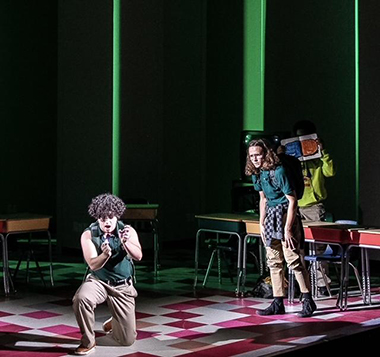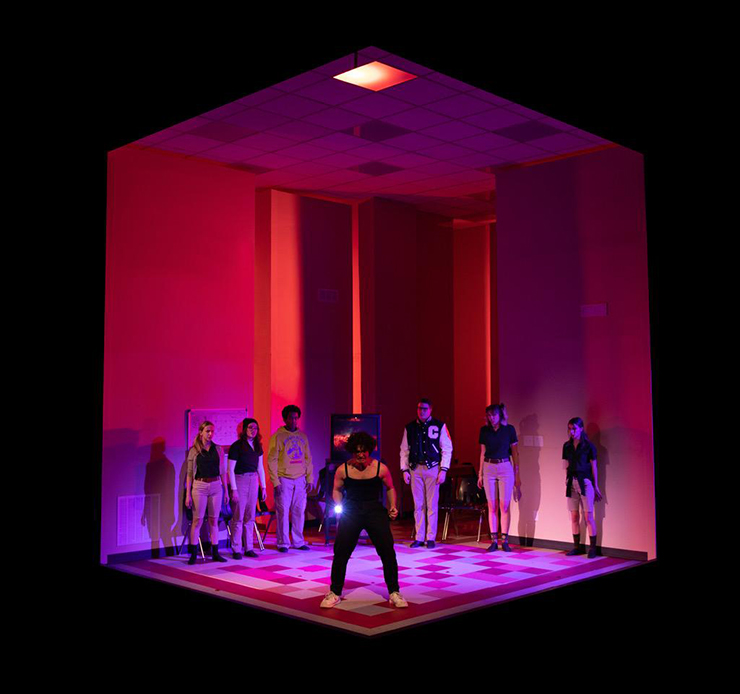
Teenage bully Rich Goranski (kneeling, played by Luke Surretsky) is the center of attention. Looking on is Jeremy Heere (played by Teddy Calvin) in Area Stage Company's "Be More Chill." (Photo by Frank Oliva)
Area Stage Company’s mostly solid professional production of the problematic sci-fi musical "Be More Chill" captures attention and sets the tone for the piece even before the show begins.
Specifically, there is no curtain. Instead, we see a young man sitting behind a desk, presumably in a classroom. His head is down and his backpack rests by his feet. Meanwhile, close by, a television is on. We see the words “Be More Chill” in big green letters flashing, one word at a time, onto the staticky screen. Also, a noise sounding like a quiet roar emanates from the television.
With that sight and sound, young, visionary director Giancarlo Rodaz, Area Stage Company’s associate artistic director, grabs from the get-go. In addition, he reveals something about the show without giving away too much.
It is the kind of effective stage picture we have come to expect in a Rodaz-directed production. One also expects minimal props and scenery. If he uses them, he will likely do so creatively. And there will be just enough to tell the story.
Rodaz’s minimalism and creativity are on display in this energetic and believable production of "Be More Chill." It runs through Feb. 27 in an intimate theater space within the Adrienne Arsht Center for the Performing Arts of Miami-Dade County, ASC’s home for at least this season. It is the professional, non-profit company’s 15th anniversary season.
The award-nominated musical stage adaptation of "Be More Chill," based on Ned Vizzini’s 2004 novel of the same name, takes place in the present in suburban New Jersey.
In the story, Jeremy Heere is an unpopular, unhappy, and quiet student at his high school, where he is a junior. Heere is about to use a device that might make him “cool” and possibly popular. In particular, the object is called a “Super Quantum Unit Intel Processor,” or SQUIP. It contains a computer that implants itself inside a person’s brain, telling the user what to do and say to be popular.
While Heere and others benefit from using the SQUIP, it is only a matter of time before the technology threatens to multiply, become more powerful, and cause more problems than solutions.
One might describe "Be More Chill," which received mixed reviews in New York and elsewhere, as a cross between "Dear Evan Hansen" and "Little Shop of Horrors." However, unlike those shows, "Be More Chill" features forgettable music, serviceable lyrics at best, a convoluted and loaded plot, distractions, and implausibilities.
For instance, it is a stretch to believe that Rich Goranski, Heere’s classmate who bullies him, would reveal to him that he became popular through a SQUIP. Why would Goranski want to divulge such a secret to someone he clearly hates? And speaking of a SQUIP, are we to believe that, even in the make-believe world of a musical, the object is for sale at a Payless shoe store? Also, why is it that Heere ends up in the hospital at the end of the musical?
If "Be More Chill" leaves us with a message, it is that we should be the best version of ourselves that we can be without letting multiple voices in our head or “inner demons” interfere too much. For such a simple message, "Be More Chill" packs a lot into its roughly two-and-a-half-hour running time.
Is this show a satire on how technology is overtaking our lives? Or is "Be More Chill" a celebration of the power of live theater and disguise? Perhaps the piece wants to impart that clinging to the past too much is unhealthy? Or that it is only proper for a father to wear pants in the house in the presence of his son? Seriously, in the musical, Heere’s father (a content, cheerful Michael Vadnal in ASC’s production) repeatedly refuses to wear pants when he is home. Nearing the end of the show, his father sings, “When you love somebody you put your pants on for them metaphorically. Or sometimes actual pants, real, literal pants.”

Lighting sometimes comes from unexpected sources in Area Stage Company's production of "Be More Chill" in the Arsht Center's Carnival Studio Theatre. (Photo by Frank Oliva)
On a more positive note, "Be More Chill" features characters with whom it is easy to identify. If you went to school with someone who was awkward or teased (perhaps you were such a person), then you can identify with Heere. Perhaps you were a “theater kid” or know somebody who was. In that case, you will likely identify with Christine Canigula, whose favorite part of the school day is play practice.
The performances are uniformly strong. And the performers can pass for high school-aged youth, even if the actors themselves are not teenagers.
Teddy Calvin, sporting long hair and glasses, plays Heere with a tentativeness that is appropriate for the character. Calvin’s fidgety Heere is tense, leans forward, walks with a hunch in his back and maintains a serious expression, all while remaining likable.
As the musical progresses, Calvin makes Heere transform believably into a more confident, content person who sits and stands upright. The actor, like his castmates, possesses a strong, expressive singing voice, although the live orchestra sometimes has a tendency to drown the singers out.
Like Heere, his best friend, Michael Mell, is also an outsider. But unlike Jeremy, Mell seems content and happy in his skin. In contrast to Heere, Mell is loose and relaxed, qualities that Aaron Hagos convincingly captures.
Similarly, Rachel Barsness radiates charm, joy, and a sense of peace as “theater kid” Christine Canigula. The performer makes it clear that her character lives for the stage.
Contrastingly, Luke Surretsky is commanding, intimidating, and menacing as the bully, Goranski. However, when it comes time for the character to reveal a sensitive side, Surretsky proves up to the task.
Meanwhile, Zachary Prall imbues popular student Jake Dillinger with an effortless charisma, while Katie Duerr is sexy and confident as Chloe Valentine, the hottest girl in school.
The cast members demonstrate deft comic timing. Credit Rodaz and the cast for allowing comic moments to land without sacrificing sincerity.
While Rodaz has developed a reputation for creatively using minimal props and scenic elements, it backfires a couple times here. In the beginning, for instance, it is not clear whether the setting is a classroom or Heere’s home. It might have been helpful to announce the setting on a projector. Also, during another moment, a hand puppet suddenly and briefly appears for an unclear reason.
Rodaz does make full use of the playing space inside the Carnival Studio Theater. For instance, having performers stand on chairs or tables to highlight them. Rodaz also paces the production well.
The scenic design, by Frank J. Oliva, consists solely of a plain room with tables and chairs that resemble a classroom. To change locations, someone from the cast or crew rearranges the desks and chairs.
The varied lighting design, by Cheyenne Sykes, nicely captures a scene’s mood and focuses performers. Intense, non-realistic green lighting that Sykes uses effectively reinforces otherworldliness. And you never know where the lighting will come from, which adds creativity and unpredictability to the proceedings.
Rebecca Levovitz’s character-defining costumes leave the performers with plenty of room to move, and the clothes are visually appealing.
In the final analysis, Rodaz and Co. mostly succeed admirably with not the strongest material to work with.
It is also encouraging that "Be More Chill" is among a crop of musicals likely to attract younger crowds. With concerns about the graying of audience members, it is a positive sign for the future of live theater.
Area Stage Company’s production of "Be More Chill" runs through Feb. 27 in the intimate Carnival Studio Theater within the Adrienne Arsht Center for the Performing Arts of Miami-Dade County. It is located at 1300 Biscayne Blvd. in downtown Miami. Performance times are 7:30 p.m. Friday and Saturday, as well as 2 p.m. Saturday, and 5 p.m. Sunday.
For tickets, https://www.arshtcenter.org/en/Tickets/Calendar/2021-2022-Season/Be-More-Chill/Be-More-Chill.




